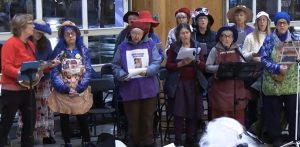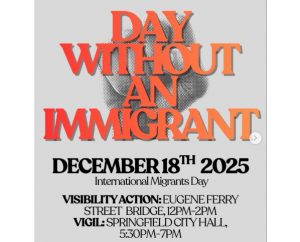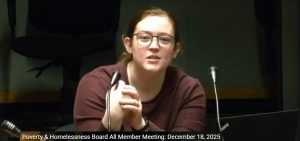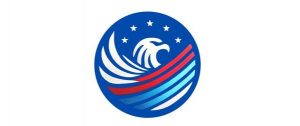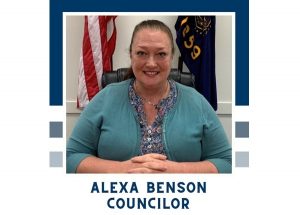LTD, transit industry educate community on labor and sex trafficking
8 min read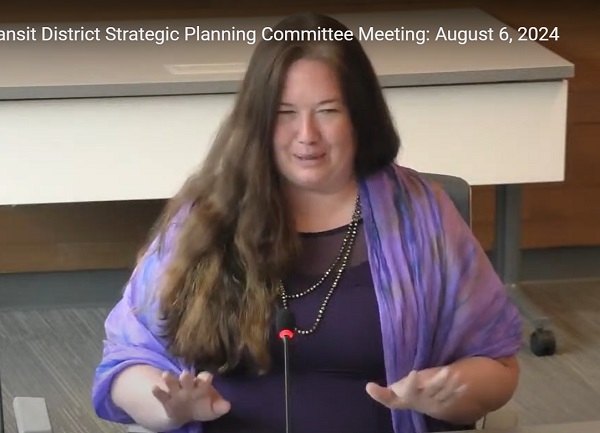
Lane Transit District raises awareness of trafficking. At the Strategic Planning Committee Aug. 6:
Sarah Koski (Lane Transit District): Hello, I’m Sarah Koski. I’m your community resource liaison here at LTD.
In the spirit of trauma-informed care, I think it’s really important, especially when we talk about things like domestic violence, trafficking, we never know if something personally affects us or if we’ve known someone who has been affected in this. Honestly, if you need to get up, get some coffee, ground yourself by washing your hands, do whatever you need to do and just take some time for yourself, I welcome it.
And I think that this is another thing that we should really start implementing in a lot of our meetings. It’s okay to just take a breath and just be like, ‘This is too heavy for me. I don’t have to like push through this.’
[00:00:48] There’s some leaders in the (transit) industry who are starting to talk a lot about trafficking and so 2023 was a huge push to get trafficking and transport out to the community. According to a 2018 Polaris survivor survey, 42% shared that their traffickers used local and/or long-distance buses in their exploitation; 54% named access to transportation as a barrier to leaving their trafficking situation.
[00:01:16] And 26%: Public mass transportation played a role in at least one exit attempt.
[00:01:23] The U.S. Department of Justice is defining human trafficking as a crime that involves ‘the exploitation of a person for labor, services, or commercial sex.’ So this includes two forms of trafficking: labor trafficking, the second definition is sex trafficking.
[00:01:44] Now, we live in a community where I would like to say that labor trafficking is not here in Eugene or in Lane County, right? However, we are seeing in Lane County labor trafficking because we have a lot of marijuana fields. And so the recruitment of young individuals who are very capricious who want to have copious amounts of marijuana—they bring them to the field, next thing they know their ID is gone, their information’s gone, they’re locked up and they’re being forced, trafficked to work in these agricultural-type communities.
[00:02:18] So, I mean, there is a whole gamut of the type of labor trafficking that we have in the community.
[00:02:24] This is a significant thing happening in our community, whether you talk on the federal level, the local municipal level, with our sheriffs, even with our task forces. It’s happening everywhere around us.
[00:02:35] The demand for the sex industry is getting younger and younger and younger as we speak. The average age last time I checked in Lane County, the demand is for a 12- to 13-year-old individual, right? And so it’s not what we’re used to, it’s very clear that the demand is for younger, it’s for youth.
[00:02:54] So recruitment is huge. One of the things that we see here in Lane County is individuals who will dress in the same type of high school sweatshirts as the high school around. And then just kind of hover around the bus stops, you know, the Kwik-E-Mart, all of these different things, recruit young people. And again, this is not predominantly female.
[00:03:13] So when it comes to this mobile crime, also the exploitation, moving an individual to and from it, I’m not saying that it’s going to always be on a bus. I mean, there’s Amtrak, there’s Uber, Lyft, anything that you can do where it’s mobile, those are what we’re seeing.
[00:03:30] When I’m starting to do research, this is what gave me a lot of hope. And the hope was transit and trafficking intersections: The amount of times that a bus or Amtrak or a Greyhound is used for an individual’s exit is astronomical because they predominantly don’t have a car, they don’t have their license at the time, so they’re going to try and use whatever they can to get away as quick as possible. And so we have this really wonderful opportunity in assisting someone’s freedom, right?
[00:04:02] And then, once you have this freedom, on that recovery side of rebuilding your life after being in that industry or in that type of work, transit is huge in recovery of jobs, recovery of family, recovery of bringing your children back into life.
[00:04:18] And so this is kind of the ‘glass half full’ portion of how we as a transit agency can really see what we’re doing here as a way to assist people in rebuilding their lives.
[00:04:33] And that’s why I love this role is, yes, it’s connecting our community, but it’s also giving a voice to those who are vulnerable. It’s allowing us to be more educated about what’s in our community.
[00:04:45] What spurred this was in April, I had the great privilege to present to our public safety supervisors and our temporary supervisors on trafficking and what trafficking looked like from a homeless lens, right?
[00:04:59] From my work at the shelter, from what we saw, and how there’s an intersection between homelessness and trafficking: 64% of women who are homeless have been actively solicited to trade sex. We’re talking, like, sex for a Happy Meal, sex for housing, 64% of those on the street, right? It’s significant.
[00:05:21] And we see this, we’re getting educated, how do we do our reporting? So my presentation to you today is the fact that we are in the beginning stage of gathering data, collecting this information, so that we can build out our policies.
[00:05:37] There are two task forces in town. The Lane County Anti-Trafficking Task Force and the Lane County CSEC (Commercial Sexual Exploitation of Children) task force.
[00:05:51] What I learned—we brought CSEC here—what I learned was, these task forces weren’t talking to each other. They didn’t even know each other existed. And so the work that we were doing to kind of elevate and collaborate now is allowing these task forces to come together and convene, which is really, really awesome. They’re opening up the doors for local public safety. LCOG (Lane Council of Governments) is also doing some work with us to get all the contacts.
[00:06:14] We’re going to bring a focus group of federal, state, county, and local police, sheriffs, feds, all of these individuals in one room. And so as we’re building out the policies, and this was what was advised to us from the task forces, is, you know, it’s all about safety, right? It’s about the safety of the individuals and traffic is about the safety of our driver operators and so we’re bringing in kind of a public safety perspective
[00:06:42] Truckers Against Trafficking has been really very vital. They created a reporting guide, it’s kind of a line by line of: Who do you call? Where do you go? And this can be, we can put our logos on it. We can fill it with local information. They created the skeleton version so we didn’t have to reinvent the wheel and it’s something that’s a national standard that almost every transit agency is doing. Truckers Against Trafficking also has offered to provide us training videos for free. Just some incredible, incredible partnerships.
[00:07:15] So when it comes to anti-trafficking work in transit, four big key points: The first one is whatever that we do here in transit, it should be number one, person-centered. Number two, built on trauma-informed response. Number three, culturally appropriate. And then, data-driven.
[00:07:37] Claire Syrett (Strategic Planning Committee): Sarah, that was a wonderful presentation. I want to actually really appreciate your self-care callout at the beginning of this because it can be a triggering topic, and it is important when we’re in a public setting, right, to give ourselves permission to recognize that that might be coming down and be prepared for it.
[00:07:59] I also want to say, appreciate your emphasis that trafficking in our community is a real thing. It’s happening right now as we have this meeting. There is data to support that when football games happen in a community, trafficking goes up. It’s a real thing.
[00:08:16] So I think the role that this agency can play in helping to intervene in that, to provide off-ramps for folks who are finding themselves, whether it’s labor trafficking or sex trafficking, and having that awareness built into the work that this agency does, I think, as you said, if it helps one person find an out to recovery, then it’s worth it.
[00:08:43] And I want to say what the very last part that you were talking about, about the fact that you’re going to convene various public safety agencies to come and have this conversation: That is a catalyst.
[00:08:57] In my experience, you know, I’ve worked for the ACLU of Oregon, I’ve worked for different organizations, and when you can bring agencies together—they want to work together, but, you know, bureaucratic inertia and other things keep that from happening. And so I’m very excited. I share your excitement about the potential for what you’re doing to create a catalyst that will be felt beyond what this agency does for the community. So thank you very much for your work.
[00:09:33] Alma Hesus (Strategic Planning Committee, chair): I was going to echo Claire’s comments about the grounding around trauma-informed mindfulness in the space when we come to space to talk about the hard things.
[00:09:42] I appreciate (CEO) Jameson (Auten)’s support of Sarah’s role and the great work that you’re doing, Sarah. It’s super meaningful. Just really do appreciate the experience that you bring to the team, Sarah, and helping us all build our awareness a little bit more around really important topics and not only for the agency, but I do wish more folks were looking and listening when you were sharing this because it’s so important for our whole community to rally around what’s important right now. So thank you.
[00:10:11] Tiffany Edwards (Strategic Planning Committee, vice chair): Since you’ve been here and doing this work, it’s been really exciting to just kind of hear about the work that LTD is doing to engage with this issue that we’re having in our community. And I think whatever we can do to help let the community know that this work is happening.
[00:10:26] So I really think that there’s a lot of value in all of that. And I think that the more we can support through just helping to spread the word that you guys are doing this important work I think it’s really important. So please just let me know how I can help with. I’ve got Thursday morning meetings every week. So if you ever want to come and present, I have a great audience for you.
[00:10:51] Thank you. Thank you for doing this, Sarah.
[00:10:58] Rob Zako (Better Eugene Springfield Transportation, executive director): I was really struck when you talked about the two task forces that didn’t know that they existed and they were convening them together, which is very near and dear to BEST— how we talk about we’re better and we speak and act together and all sorts of all about partnerships and working together.
[00:11:12] But I’m noticing the mission of LTD which is ‘connecting the community,’ and I guess we think of that as really physically connecting but bringing a task force together as part of connecting the community, that’s how we make things happen. So thank you for all you for good work.
[00:11:26] John Q: Sarah Koski tells the Strategic Planning Committee: Transit agencies are helping to educate the community about trafficking and helping to rebuild lives.
